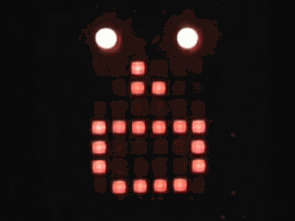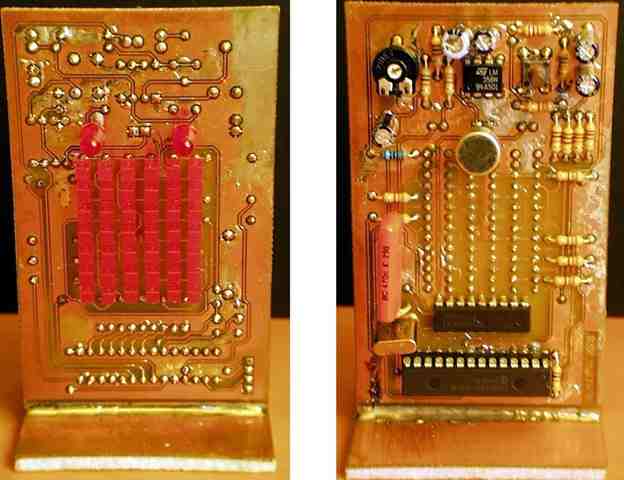
Funny robot application is a fun app 🙂 Speaking software installed on PIC18F2455 with CCS C prepared according to the audio signal around talking smiley made of LEDs. Also working in windows environment with source code in JAVA based program’s
When I first saw the cloned Tengu developed by Alex on the Hackaday blog, I thought it was a suitable project to learn to use certain functions of PIC microcontrollers such as A/D converters, interrupts and timers.
After examining the features of the original Tengu developed by Crispin Jones, I started to determine the requirements for my own clone.
I decided to add a simple game that aims to turn it into a personalized birthday present; my sister’s birthday was near.
It is very easy to use. After connecting the PIC-Tengu to a USB port, it will boot in sleep state. He will wake up by blowing on his face. Then the PIC-Tengu yawns and starts the candle game if and only if we are using it for the first time.
The object of this game is to blow out the candles one by one, so it can be pretty boring if the honoree is over a certain age, but less painful than pulling their ears. Fortunately, my sister is only 25 years old.
A personalized ticker appears when the game is over.
Later, PIC-Tengu begins to imitate every sound it hears. Four sets of faces are available: eagle-nosed, snub-nosed, noseless, and Luciano. The active face set changes with a blowing or strong sound. Pic-Tengu audio sensitivity is configurable via the rear potentiometer.
Pressing this button toggles between imitation mode and tickertape mode. If we hold down the button for more than 2 seconds, the PIC-Tengu will reset and return to the same state as if it was never used before; this means the candle games will reappear after you wake him up.
Finally, if there is no activity for more than 5 minutes in emulation mode, the PIC-Tengu will go to sleep. The brains of this project is a PIC18F2455 whose pins directly activate the matrix rows of the LED. There is only one column of LEDs active at any given time, which is determined by pins PIC18F2455, but this time using an intermediary ULN2803.
The signal captured by the microphone is amplified using an LM358 before reaching an analog input at the PIC. The firmware is written in CCS C and written using the parallel port version of PIC, GTP Lite and WinPIC800.
It also has a JAVA-based program that works in the windows environment with its source codes.

The brain of this project is a PIC18F2455, whose pins directly activate the LED’s matrix rows. There is only one LED column active at any given instant, also determined by the PIC18F2455 pins, but this time using an intermediary ULN2803. The signal captured by the microphone is amplified using an LM358 before reaching an analog input in the PIC. The firmware is written in CCS C, and the PIC has been burned using the parallel port version
source uchobby.com PIC18F2455 PIC-Tengu CCS C Talking Robot files alternative link:
Şifre-Pass: 320volt.com
Publication date: 2008/02/24 Tags: ccs c examples, microchip projects, microcontroller projects
RMS 500W Amplifier Circuit
System 500W RMS at 4 ohm 620W RMS power gives 2Ω, 4Ω 500W RMS, 8Ω 380W RMS Circuit of the original scheme 8 MOSFETs used and 4Ω 400W writes 2Ω speakers in order to work 10 mosfet I used the original transistors toshiba 2SK1530 and 2SJ201 but the price is expensive to have found IRFP240 and IRFP9240 have used the results are obvious works perfectly.
Warming normal or even slightly cooler in long-term studies sufficient for the circuit printed circuit board myself drew not cite what I ölçd if I have written her in an open field with two 1600W 8Ω estra cabin for 1 h with’ve tried so far professional systems aratmadı attempt pictures no wish pulls’m some but again another time balls I put
500W Mosfet Amplifier Project
PIC18F2455 PIC-Tengu CCS C Sprechender Roboter
Die lustige Roboteranwendung ist eine unterhaltsame App 🙂 Die auf dem PIC18F2455 installierte Sprachsoftware mit CCS C wurde entsprechend dem Audiosignal rund um den sprechenden Smiley aus LEDs erstellt. Arbeitet auch in einer Windows-Umgebung mit Quellcode in JAVA-basierten Programmen